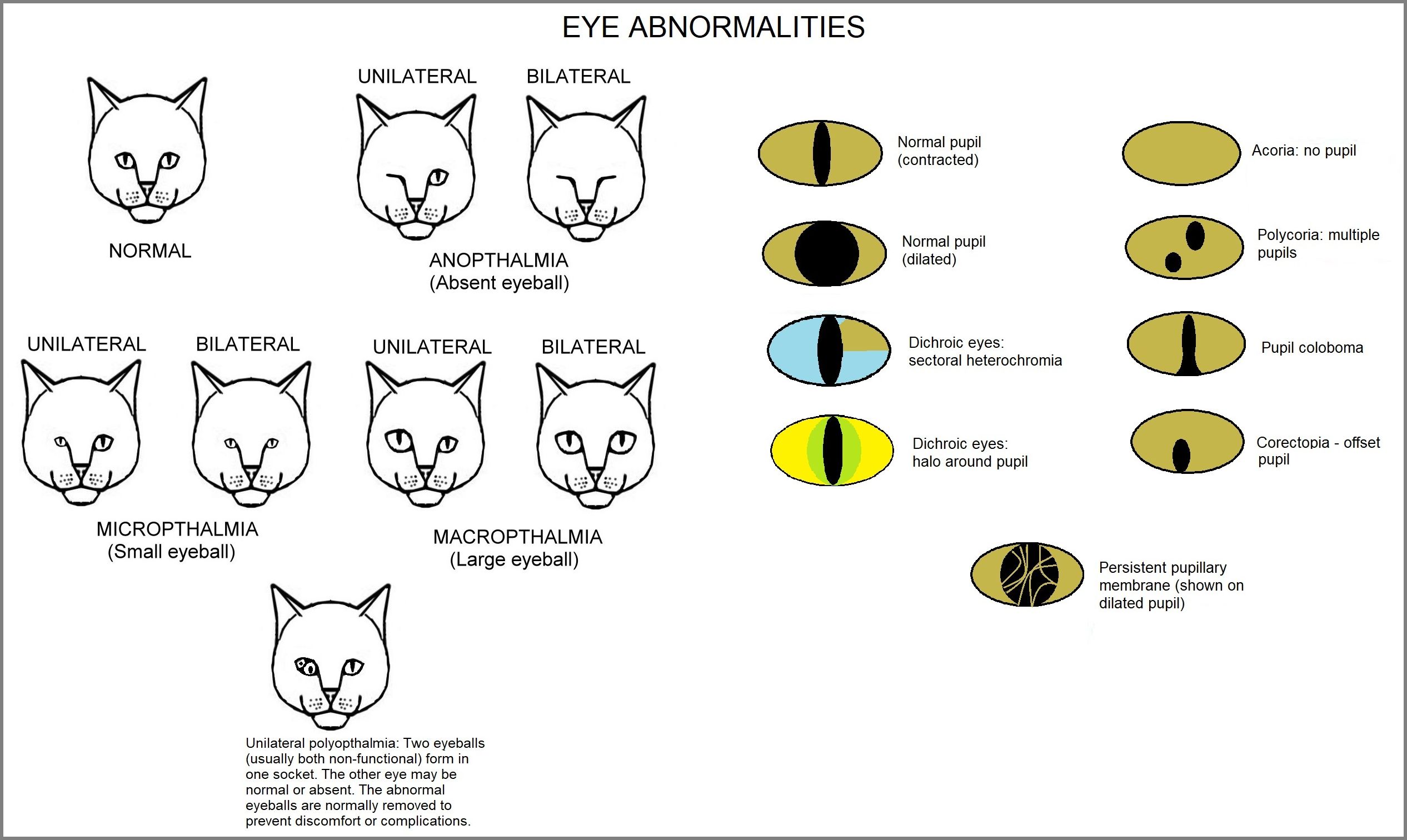
FELINE MEDICAL CURIOSITIES: FACIAL DEFORMITIES
Anomalies of the Eyes
Note: Contrary to suggestions on some bulletin boards, the images here are not photoshop. With the exception of those labelled as artist's impressions these are photos of medical conditions. These pages are intended as a medical reference site. Offsite links to images on these pages is not supported - bandwidth costs money!

HYPERTELORISM (WIDE SPACED EYES) & HYPOTELORISM (CLOSE SET EYES)
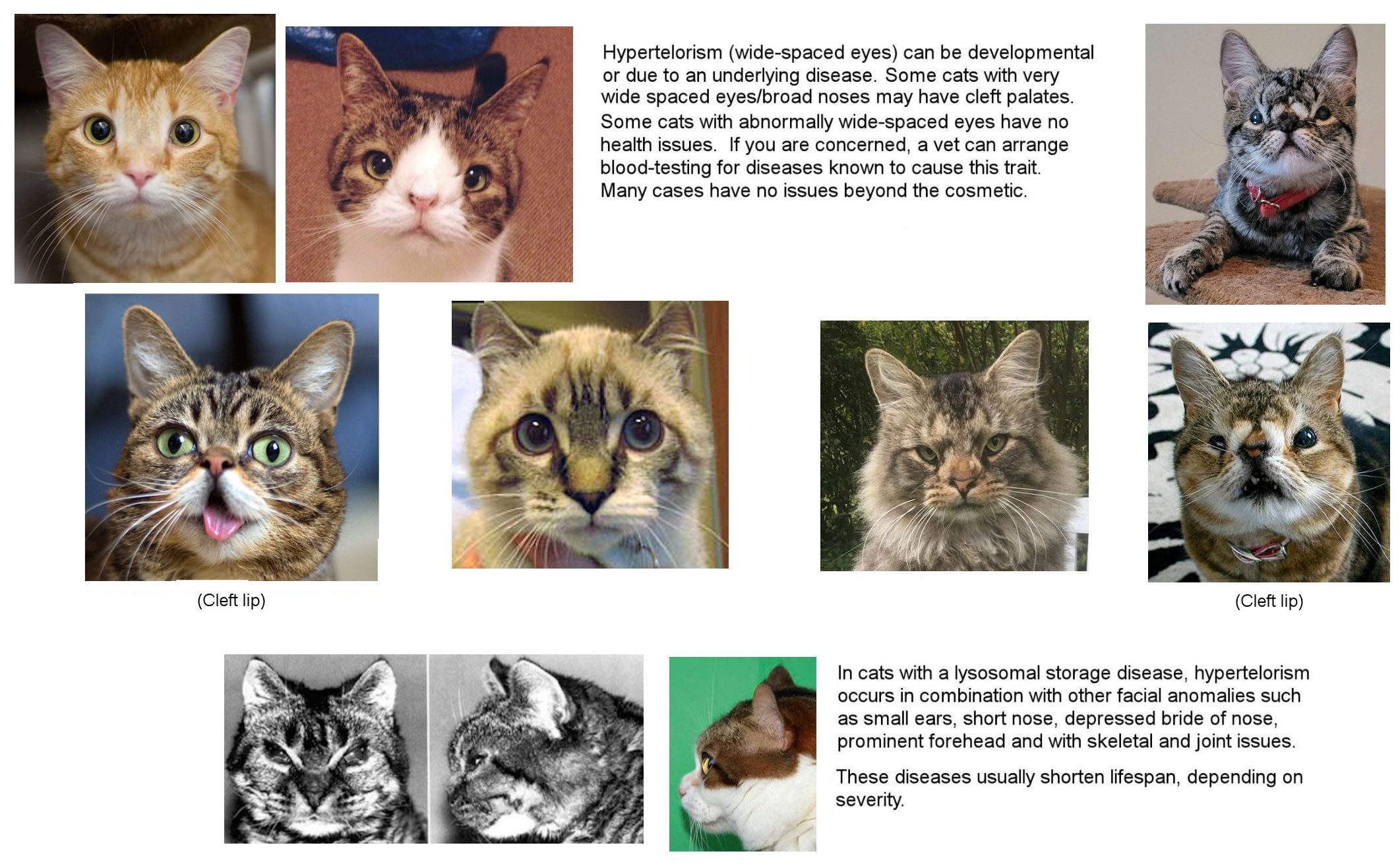
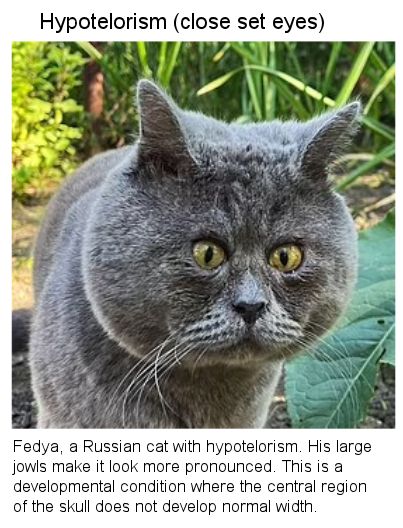
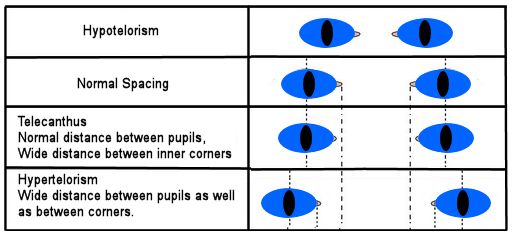

COLOBOMA
Coloboma is an eye condition that occurs when part of the tissue of the eye or eyelid is missing. A gene mutation means the eye doesn't develop normally during pregnancy. It can be hereditary or caused by environmental factors, such as the mother being exposed to chemicals during pregnancy. It can affect one or both eyes. Scientists have identified some of the genes that can cause coloboma. In humans, coloboma can be associated with a mutation in the PAX2 gene and the same genes can also cause anophthalmia and microphthalmia. The gene in cats has not been identified.
Different types of coloboma affect different parts of the eye: iris, uvea, lens, retina, optic nerve, and/or eyelids. In cats, eyelid coloboma and iris coloboma are the visible forms. Eyelid coloboma appears as a notch in the upper (usually) or lower (less commonly) eyelid. Iris coloboma means part of the iris is missing, making the pupil abnormally shaped. This can cause light sensitivity because the pupil allows too much light into the eye and cannot fully contract. In the 2 cats below (photos by Rano Makarenko) the pupil coloboma looks like notches in the coloured iris.

PERSISTANT PUPILLARY MEMBRANE - See:Persistent Pupillary Membrane
MICROPTHALMIA & ODD-SIZED EYES
|
Darth Vader |
Silver tabby kitten |
Sometimes a cat is born with one eye larger than the other. The accompanying photo (from Tim Becvar) shows one such cat. The cat is called Darth Vader (but nicknamed "Bigeye") and comes from Portland, Oregon. The mismatch in eye size can be mild or very pronounced. Occasionally one eyeball may be absent. This assymmetry may extend to the whole face with one side of the face being smaller or less developed than the other. The term for tiny eyeballs is micropthalmia - one or both eyes may be affected. It is a non-inherited, developmental issue and can occur randomly in purebred, as well as randombred, cats. The silver tabby kitten is from purebred Bengal parents and the defect may have been caused when its mother received medication during pregnancy. He is otherwise perfectly healthy.
I encountered a micropthalmic cat, a small feral female called Louisa at Chelmsford Cats Protection shelter in the early 1990s. Louisa had one normal eye and one very small eye. The undersized eye was scarred, probably from infection, and had little vision.
Erin Gerwing sent these details and photos of her cat Leroy Brown who has unilateral microthalmia (tiny eyeball on one side). Erin works at a veterinary clinic where 6 kittens were dropped off after being found abandoned. One kitten died and was found to have only one kidney. Another died of probably FIP. A third, Leroy, was perfectly healthy, but appeared to have a missing eye. The socket was oozing thick pus and the infection started making him generally unwell. During surgery to clear out his eye socket, he was found to have microphthalmia on that side.
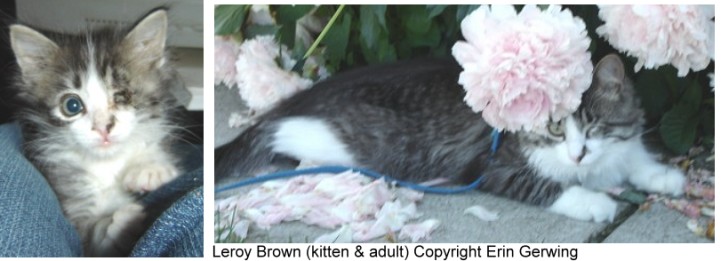
Lizzie Ellis (The Feline Rescue Association Inc, Maryland, USA) provided these photos of a kitten named "Fox." She looks like she has anophthalmia, due to the sunken appearance of the eye sockets, but she does have tiny eyeballs in there and seems able to see at least a little bit.
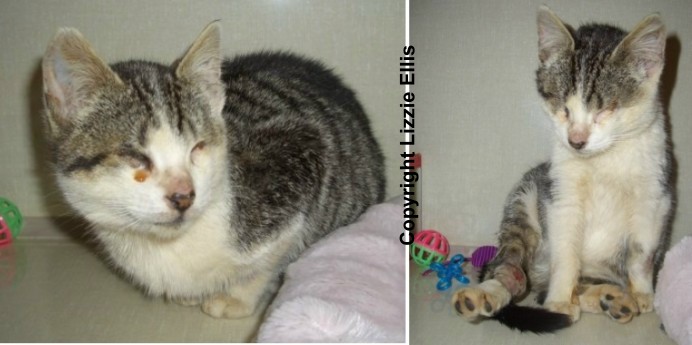
Mary Jo Callahan (Arcadia, Florida) provided this photo (below) of her 50 day old kitten, which looked as though it had both eyes in one socket. One socket is empty, but the other has an enlarged, deformed eyeball present. Unfortunately, this would require a vet to determine whether the deformed eyeball is causing distress or provides vision, or is likely to continue expanding due to build of pressure within the eyeball. If it caused distress, the eye would have to be removed leaving the kitten blind, but more comfortable.

MACROPTHALMIA
Macropthalmia refers to a condition where either the eyeball(s) or the whole eye(s) is/are abnormally large in size due to anomalous eye development. The lens often detaches (luxation) or there are cataracts and the cat is generally blind. Cats are very stoic and may not show discomfort, but the pressure of grossly enlarge eyballs on surrounding tissue causes discomfort or pain and the eyeball should be removed to alleviate this. The enlarged or protruding eye combined with loss of sight means an increased risk of injury to the eye (and subsequent infection). Macropthalmia can be genetic (as evidenced by 3 affected littermates) or congenital.
Honey Bee was born with unilateral microphthalmia and unilateral macrophthalmia - one eye was abnormally large and the other abnormally small. "Animals Fiji" took her in and removed both eyes (since they didn't function) and Honey Bee was later adopted by a family in the USA. She makes up for blindness with her senses of hearing and smell, is a happy and active cat, and enjoys walking on a leash.
In 2013/2014 I was sent a YouTube link to a cat with glaucoma/swollen eyeballs, but there was little information available. The cat appeared to be happy and active. Dubbed GlaucomaCat, she has a congenital disorder that has led to extremely large eyes; it is not known what caused this. However, as a result, she has severe glaucoma (pressure in the eyes) and cataracts; the glaucoma has resulted in total loss of retina function and, thus, blind.
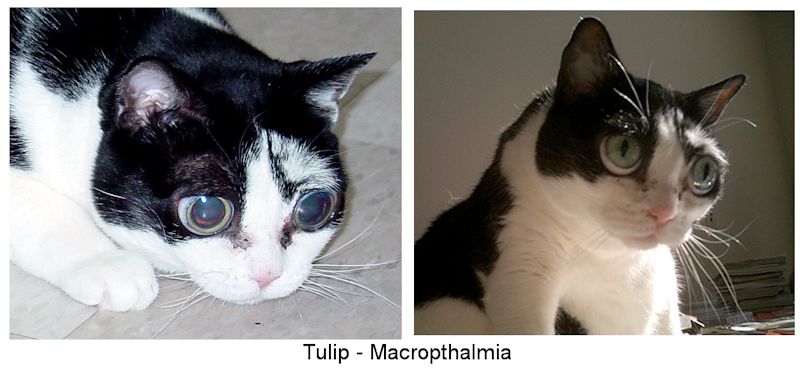
In 2015, Matilda hit social media and news media due to her huge, glassy eyes and her alien appearance. This shelter kitty was normal until her first birthday when first one, and then both, lens detached. Two of Matilda's littermates also developed a mysterious eye condition. Matilda, and presumably her siblings, has a collagen deficiency which makes it difficult to heal from injuries and surgery. This is why surgery has been put off for so long. A veterinary ophthalmologist Dr. Matthew Fife (who is not Matilda's vet) says the main problem, in addition to the detached lenses, is glaucoma (pressure in the eyes); the pressure is very high, causing the eyeballs to enlarge and stretch. He states "It's actually pretty painful." The owners claim that the condition is not caused by glaucoma. Despite the owner's claims of her not being in pain, Matilda will probably be far happier and more active when her swollen eyeballs are removed.
ANOPTHALMIA
|
The peculiar shaped face of this five week old black-and-white kitten is due to hydropcephaly and anophthalmia. |
Young Persian-cross cat with anopthalmia. |
Anophthalmia means "no eyes". The kittens above have empty eye sockets. The black-and-white kitten above was born at a cat shelter in England. Unfortunately he had hydrocephaly in addition to anopthalmia and as his condition deteriorated (progressive neurological symptoms) it was necessary to euthanize him. There are many, perfectly contented blind pet cats and blindness alone would have caused the kitten no problems as a pet in a safe environment. The Persian cross cat was another case of anophthalmia, this time with no other abnormalities. It is apparently a happy, healthy indoor pet. Note: Some apparently eye-less cats have microphthalmia, where the eyes are present, but are tiny and (depending on the severity of the micropthalmia) may be partially functional.
These photos from Joshua Dabbs (2012) show a silver tabby kitten with unilateral anopthalmia. His face is also misshapen: slightly sunken on the side without the eye. When he was given his intranasal vaccinations, it was found that the kitten had one functioning nostril. This suggests one side if the skull and face are underdeveloped. However, the kitten is healthy and thriving and will be able to live a happy, healthy life.
|
|
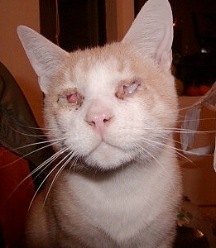
This photo is of 10 year old Ghost (as of 09/2007), who was born without eyeballs. Ghost was found wandering around Seattle with his mother and another kitten a sister to Ghost when he was about 1 month old. They were all taken to a no-kill shelter (which is probably why Ghost wasn't put down immediately). Ghost and the other kitten, Sammie, were both adopted when they were around 2 months old. Having been blind from birth, Ghost copes well with his condition. He is extremely affectionate, demands attention, and acts more like a small lap dog than the average cat. He is also very large at 17 pounds, but is not fat just big! Blind cats compensate with more acute hearing and seem to be more aware of vibrations in the air (perhaps through their vibrissae, or whiskers). Ghost can catch flies out of the air, and loves supervised trips outdoors. Oddly enough, one of his favourite things to do is to sit in the window perhaps to better hear the activities of the outside world. Like most cats, he is a good climber, and loves to explore his environment. His right socket is sometimes a little red and secretes slight amounts of pus, though this doesn't seem to bother him much. His owner, RW Campbell, keeps the socket clean with a damp, warm cloth (much as Ghost hates the procedure), and sometimes his cat-mates will clean Ghost s face for him though Ghost is good about doing it himself. In spite of his somewhat alarming appearance, Ghost is a happy, healthy cat, and not distressed by his empty sockets. Note: Many vets will stitch the eyelids together over an empty socket, to protects the socket and improve the cosmetic appearance of the animal.
Glaucoma can also be a congenital eye problem in kittens and may result in the removal of one or both eyes early on (as the kitten already has little or no sight in the affected eyes, this is to prevent pressure build-up and pain). The eyes become cloudy and unresponsive to light and internal fluid build-up causes swelling. It is more common in cats with Siamese or Abyssinian ancestry. Following surgery, the lids are normally sewn shut and the effect resembles anopthalmia.
EYELID ATRESIA (NO EYELIDS)
In 2007, Larissa wrote to me about her neighbour's cat who was born without eyelids. She noticed the cat was behaving as though the eyes were dry or uncomfortable (squinting slightly; tear stains down both sides of her nose). The cat had been born without eyelids. She was the only kitten in the litter affected this way and the vet believed it might have been due to exposure to a virus during gestation. The cat is otherwise happy and healthy, but requires several applications of eye ointment each day to be comfortable. She appears to be fully sighted.
Eyelid atresia is variable in degree. In some cases only the margin of the eyelid is missing; this causes the fur to constantly and painfully rub on the sensitive cornea (surface of the eye). This eventually causes blindness. If left uncorrected, affected cats usually keep their eyes closed all the time. It can be surgically corrected, the results being functional, but not pretty. In other cases, where more of the lid is missing or the lid doesn't fully close, eye ointment is needed to lubricate the eye.
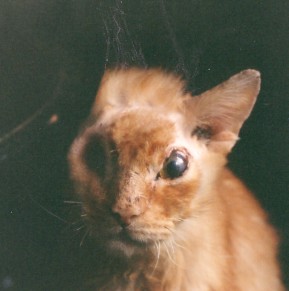
Leo lacks an upper eyelid following reconstructive surgery, but his appearance is similar to that of a cat with congenital eyelid atresia. The lower lid closes to partially cover the eye. He was partially sighted and his eye was kept moist with ointment.
MORE ANOMALIES
If you have come to this page directly from a search engine, please check out
FELINE MEDICAL CURIOSITIES for the full index of topics includingBOOKS ABOUT ANOMALIES
If you are interested in medical curiosities, books worth reading are "Mutants: on the Form, Varieties and Errors of the Human Body" by Armand Marie Leroi and "Anomalies and Curiosities of Medicine Vols 1 and 2" by George M. Gould & Walter L. Pyle. The Gould & Pyle books were published in 1896 and are in the public domain. You can download text-only versions of Gould & Pyle from several websites so don't waste money on text-only versions of the book; but if you want the versions with photos, consider the Kessinger editions. The Leroi book explains why and how some deformities and anomalies happen - the mechanism is the same in cats as it is in humans.
You are visitor number